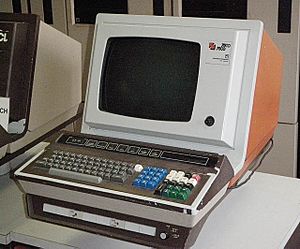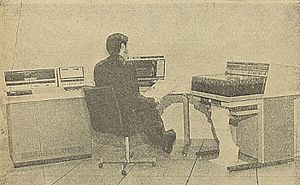ICL 7500 series facts for kids
The ICL 7500 series was a group of computer terminals and workstations. These were made by a company called ICL in the 1970s. They were designed to work with ICL's big ICL 2900 Series mainframe computers.
The 7500 series included different models like the 7501, 7502, and 7503. The 7561 was a common name for the screen part of these systems. The 7501 and 7502 were also called "Modular Terminal Processors."
Contents
What Was the ICL 7502?
The 7502 was a main part of the ICL 7500 series. It was a computer box that held many important parts. These included the CPU card (the brain), memory cards, and video cards for the screen.
It was about the size of a desktop computer tower, but it lay flat. It was built to fit into an office, so it had nice wooden cabinets. Inside, it had foam to make it quieter.
The 7502 could connect to many devices. It could link up to eight 7561 screens. It could also connect to four printers. It had space for two 8-inch floppy disk drives.
How Was the ICL 7501 Different?
The 7501 was a smaller version of the 7502. It was built right into the base of a 7561 screen. It had fewer slots for internal cards. This meant it could connect to fewer extra screens, usually just one.
Both the 7501 and 7502 worked very similarly. They used the same software. They had a special memory (ROM) that helped them start up. This allowed them to load software from the main computer or from a floppy disk.
The ICL 7503: A Special System
The 7503 was another system in the series. It was often used for "Remote Job Entry." This meant it could send large tasks to a main computer from far away.
It was different from the 7502 inside. The 7503 usually had a printer and a card reader built into a larger desk.
The 7561 Screen: A Closer Look
The 7561 screens were special. They were "memory-mapped," meaning the computer could draw directly onto the screen. This made them very fast. The screen showed green text.
The keyboards were separate. They had a special feature for security. Users could use a magnetic pen to identify themselves. This helped control who could access certain information.
Later versions of the 7561 screen had better displays. They could show 25 lines of 80 characters. Some could even show more characters on the screen.
How the 7502 Handled Graphics
The 7502 was very good at updating its screen. The processor (the computer's brain) could directly control what appeared on the screen. This was different from other systems where the processor had to tell a separate part what to do.
This direct control made the 7502 very fast. It could quickly move text around, like when you scroll up a page. It could also change how text looked, like making it flash or appear in italics.
How the 7502 Processed Information
To work even faster, the 7502 used two sets of internal memory areas called registers. When the computer needed to do something urgent, like an interrupt (a quick task), one set of registers would pause. The other set would then handle the urgent task. After the task was done, the paused information would be put back. This made sure the computer could handle many things at once without slowing down too much.
Printers and Storage
The 7501 and 7502 systems used dot-matrix printers. These printers made images and text using tiny dots. Different models offered various printing speeds.
The 7503 often connected to a card reader and a faster line printer. Later, the 7502 could also use faster "Band Printers."
For storage, all three systems used 8-inch floppy drives made by CDC. However, the 7502 often didn't need a floppy disk. It could get its software directly from the main computer through a connection. This was called "teleloading."
The software that ran these terminals was called a "Terminal Executive" (TE). Different TEs were used for different jobs and connections.
What They Were Used For
The main job of the 7500 series was to be a "communications front-end." This means they helped users connect to the big mainframe computers. Most of the actual computing work was done by the mainframe.
The workstations had some basic abilities. They could check if data was entered correctly, like making sure numbers were in the right place.
Later, a way to create simple programs was added. This was called Transaction Processing Language (TPL). It allowed users to make their own screen forms and small applications. These applications could be saved on floppy disks.
Games on the 7500 Series?
Believe it or not, some clever developers even made games for the 7500 series in the early 1980s! Games like "PacMan" and "Space Invaders" were created. The 7500 series' fast screen handling made it perfect for these games.
The ICL 7500 series was eventually replaced by the ICL DRS series of computers.



